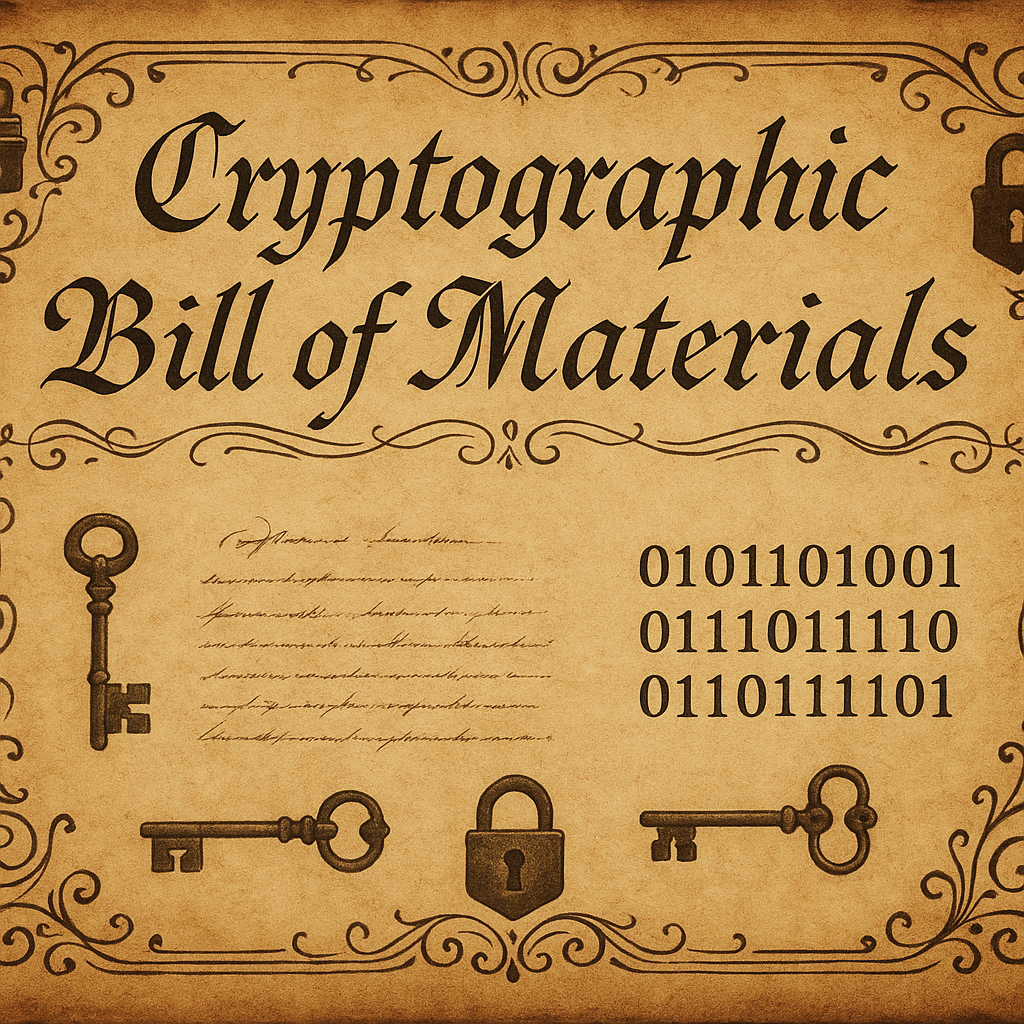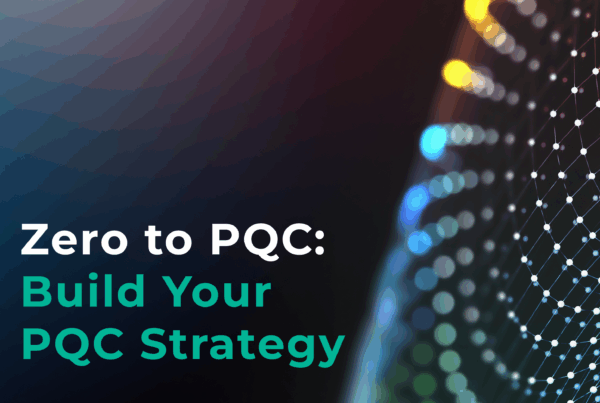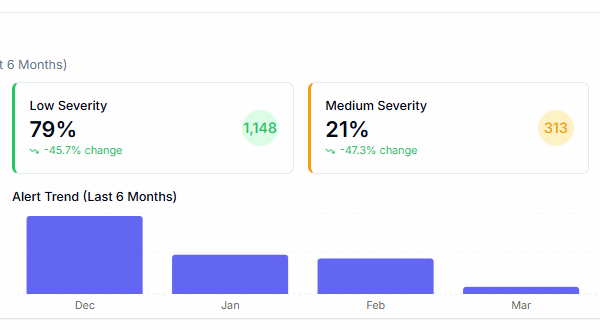Making CBOMs Useful — How Cryptographic AI² Transformed Our Approach
At QryptoCyber, we began with a straightforward but ambitious mission: accelerate post-quantum cryptographic readiness by shortening cryptographic audits from years to weeks. Our initial strategy was to conduct comprehensive cryptographic discovery and produce Cryptographic Bills of Materials (CBOMs) for our clients.
We liked the idea of CBOMs as a detailed inventory of all cryptographic assets in an organization. However, we quickly found that a static CBOM – often just a massive document– was not very useful on its own to anybody.
Traditional CBOMs tend to become static artifacts that are outdated almost as soon as they’re created. They provide visibility into cryptographic assets, but they rarely guide action or adapt to new threats. In short, a CBOM alone gave us a checklist that was random order, but not a roadmap for our customers to follow to PQC success.
The second challenge that we faced was “how do we gather the information when every customer is radically different in terms of risk appetite and tech stack?” Installing new software in enterprise environments causes months and weeks of delays in PQC projects only to be told no at the end of the day. So the question became how do we build something that is adaptable to the infinite variety of technology combinations while maintaining the necessary integrity of the information?
The limitations of a static inventory led us to rethink our approach to… well pretty much everything. We needed a way to make the cryptographic inventory continuously up-to-date and immediately actionable while adapting to an infinite number of methods, means and requirements that drive the actual data collection of the cryptographic inventory. That realization gave birth to Cryptographic AI² – our AI-driven solution to transform a passive inventory into an active, adaptive cryptographic management system that works with the available tools (ours or yours) to gather the necessary information.
From Zero to PQC.
Cryptographic Adaptive Inventory Artificial Intelligence (Cryptographic AI²) takes your specific environment: tools, assets, and cryptography and builds your PQC strategy from the ground up.
What is Cryptographic AI²?
Cryptographic AI² (short for Cryptographic Adaptive Inventory Artificial Intelligence) is our answer to the shortcomings of static CBOMs. It’s not just an AI-enhanced data collection tool – it’s a dynamic platform designed to convert cryptographic inventory data into continuously adapting remediation workflows that can be configured to all of the available tools and methods already present in an enterprise environment. In essence, Cryptographic AI² bridges the gap between knowing what your cryptographic assets are and acting on that knowledge in real time without requiring a rebuild of your tech stack.
Cryptographic AI² uses artificial intelligence and automation to analyze your environment, prioritize risks, and orchestrate fixes. It adapts to each organization’s unique mix of systems and tools, ensuring that the cryptographic inventory is always up-to-date and always driving actionable steps. Think of it as moving from a static list of encryption components to a living system that not only inventories your cryptography, but also helps you manage and upgrade it on an ongoing basis. This approach is explicitly built for the post-quantum era, when organizations need to replace vulnerable algorithms and certificates proactively rather than reactively.
Why Traditional CBOMs Fall Short
A Cryptographic Bill of Materials is a great concept in theory: it catalogs all encryption algorithms, keys, certificates, and libraries in use. The problem is what happens next. In practice, a traditional CBOM is a snapshot in time. And in random order. It’s typically a document or spreadsheet that captures only static information about the cryptographic environment.
As IT systems evolve with new services, updates, and devices, that snapshot becomes stale. Organizations that rely on interviews and spreadsheets to build a CBOM often gain a false sense of security, believing they have the full picture while missing new vulnerabilities and changes and most importantly understating risk to the organization.
Moreover, a static CBOM lacks context and prioritization. It might list hundreds or thousands of cryptographic items without indicating which ones pose the greatest risk or which should be fixed first. Teams are left asking, “Now what?” All too often, the CBOM ends up filed away, satisfying a compliance requirement but not driving any tangible security improvements that are required to protect your data.
We realized that to truly be useful, a cryptographic inventory must be dynamic and tied directly into both the risk and remediation processes.

Why Traditional CBOMs Fall Short
A Cryptographic Bill of Materials is a great concept in theory: it catalogs all encryption algorithms, keys, certificates, and libraries in use. The problem is what happens next. In practice, a traditional CBOM is a snapshot in time. And in random order. It’s typically a document or spreadsheet that captures only static information about the cryptographic environment.
As IT systems evolve with new services, updates, and devices, that snapshot becomes stale. Organizations that rely on interviews and spreadsheets to build a CBOM often gain a false sense of security, believing they have the full picture while missing new vulnerabilities and changes and most importantly understating risk to the organization.
Moreover, a static CBOM lacks context and prioritization. It might list hundreds or thousands of cryptographic items without indicating which ones pose the greatest risk or which should be fixed first. Teams are left asking, “Now what?” All too often, the CBOM ends up filed away, satisfying a compliance requirement but not driving any tangible security improvements that are required to protect your data.
We realized that to truly be useful, a cryptographic inventory must be dynamic and tied directly into both the risk and remediation processes.
How Cryptographic AI² Works
Cryptographic AI² transforms a static cryptographic inventory into a fully actionable plan through several key capabilities:
1. Pre-Inventory Strategy Planning
We start by helping your team outline what to look for. Using simple, natural-language prompts, we ask about five foundational areas –, your IT assets, operating systems, critical applications (like ERP systems), operating systems, cloud environments and potential sources of data discovery already present within your environment. With these inputs, Cryptographic AI² generates a tailored cryptography discovery strategy that reflects your organization’s specific technology stack and risk profile. By taking this approach we provide you with the ability to address hard to reach areas of your environment while also helping you develop the data necessary to address all of the different stakeholders in an enterprise wide PQC process.
2. Cryptographic Correlation Matrix
Once the discovery begins, our AI correlates what should be in your environment versus what is actually found while also developing strategies that allow you to address those hard to reach areas of your network.. We map the discovered cryptographic assets to any gaps or unexpected findings. For example, if you believe all your web services use TLS 1.3 but we find a few still on TLS 1.0, those gaps are highlighted immediately. If your organization funds different parts of the network from different budget line items we enable you to create specific reporting to support that structure. This correlation provides crucial context that a basic CBOM would lack – it flags incomplete or misaligned inventory items and ties them to business risk and meets the needs of your internal stakeholders.
3. Five-Pillar Inventory Execution
Cryptographic AI² conducts a comprehensive data driven assessment of your environment across the five essential pillars of cryptographic inventory. This Five Pillars framework ensures no area of encryption goes unchecked:
- External Network: We identify all encryption visible outside your organization’s perimeter. This includes external-facing SSL/TLS endpoints, certificates on your public websites and APIs, and any digital signatures or secure channels used with customers and partners.
- Internal Network: We examine how data is protected as it moves within your internal systems. This covers encryption for internal APIs, service-to-service communication, internal cloud traffic, and messaging queues.
- IT Assets: We inventory encryption on endpoints and infrastructure. This pillar covers servers, user devices, and IoT devices. Cryptographic AI² discovers things like certificates in device trust stores, disk encryption status on laptops, keys in hardware security modules (HSMs) or TPMs, and encryption used by IoT sensors.
- Databases: We analyze your databases to ensure data at rest is properly encrypted and managed. This involves checking which databases exist and how they encrypt data, and assessing how encryption keys for databases are stored and rotated.
- Code: We scan your application source code and compiled binaries for any cryptographic usage. This helps identify hard-coded secrets, use of deprecated algorithms, and any custom cryptographic implementations that might not be quantum-safe.
4. CBOM Generation
After collecting data from all pillars, Cryptographic AI² generates a Cryptographic Bill of Materials – but unlike the static CBOMs of old, this one is live and rich with detail. The CBOM is output in a machine-readable format, complete with metadata about each item, confidence scores for the findings, and links that trace how an asset was discovered.
5. PQC Strategy Generation
With the complete inventory in hand, Cryptographic AI² automatically crafts a post-quantum cryptography (PQC) strategy tailored to your organization. This strategy document outlines what needs to be done to transition your environment into alignment with quantum-resistant standards.
6. PQC Roadmap Construction
Strategy is useless without execution, so the final capability is building a detailed remediation roadmap. Cryptographic AI² takes the strategy and breaks it down into concrete steps and timelines. Each task in the roadmap is aligned with the resources and tools needed to do the job. This plan is not static either; as your inventory changes or as you complete tasks, the roadmap automatically updates.
From Insight to Action: Automated Remediation
One of the biggest advantages of Cryptographic AI² is how it drives immediate action from all these insights. It doesn’t just hand you a report and leave you figuring out remediation. Instead, it orchestrates the move from analysis to execution in a few important ways:
- Task segmentation into manageable units
- Integration with ticketing and workflow tools
- One-click or fully automated remediation
- Optional connection to expert cryptographic remediation partners and PQC tools
This orchestration drastically reduces the time and manual effort required to resolve cryptographic vulnerabilities and stay secure.
Continuous Cryptographic Management
Perhaps the most important shift with Cryptographic AI² is moving cryptographic management from a one-time list to a continuous process that reflects the latest code, applications and network changes. The cryptographic environment of any large organization is not static; it’s constantly evolving. Cryptographic AI² is built with this reality in mind. It performs ongoing discovery and monitoring so that your cryptographic inventory never goes stale. As new assets or changes are detected, they’re added to the inventory automatically.
Ready for Today, Prepared for Tomorrow
Cryptographic AI² has transformed how we, and our clients, approach cryptographic inventory and remediation. When you get the inventory right and keep it adaptive, it becomes the foundation for a strong cryptographic strategy and a practical roadmap to act on. In our experience, having this solid inventory and plan is a game-changer: it gives you clear direction on what to do first, a way to execute changes rapidly, and confidence that you’re not overlooking hidden risks.
Most importantly, this approach ensures that your organization stays ahead of the curve. As new quantum-resistant algorithms emerge and standards change, your adaptive inventory will highlight what needs updating. Cryptographic AI² helps ensure you are ready for today’s cryptographic risks and prepared for tomorrow’s.
If your current cryptographic management still relies on static spreadsheets or once-a-year audits, it’s time to modernize. QryptoCyber’s AI-powered platform is the best place to start – we leverage the Five Pillars framework and intelligent automation to kickstart your journey to a quantum-safe posture. Your CBOM doesn’t have to collect dust on a shelf; with Cryptographic AI², it becomes a living, actionable asset that will safeguard your organization in the quantum era.








